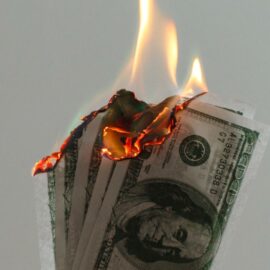

This article is an excerpt from the Shortform book guide to "You Can Be a Stock Market Genius" by Joel Greenblatt. Shortform has the world's best summaries and analyses of books you should be reading.
Like this article? Sign up for a free trial here.
When’s a good idea to invest in stub stocks? When a company recapitalizes, can you make a profit by investing?
Stub stocks are stocks revalued after a company’s recapitalization or restructuring. For example, if a company were to repurchase shares from its shareholders, the stub stocks would be the leftover, lower-priced stocks available for purchase afterward.
Learn more about how to invest in leveraged companies with stub stocks.
Investing in Leveraged Companies With Stub Stocks
In You Can Be a Stock Market Genius, hedge fund manager Joel Greenblatt discusses specialized opportunities that arise when companies are heavily leveraged—in other words, when they take on debt. In this article, we’ll discuss why highly leveraged stub stocks are desirable investments according to Greenblatt.
How to Profit From Stub Stocks
Stub stocks, Greenblatt clarifies, emerge whenever a company chooses to recapitalize—that is, when it pays shareholders either cash or other securities so it can repurchase large quantities of its own stock. Greenblatt argues that stub stocks provide a favorable investment opportunity because they amplify companies’ increases in earnings while limiting downside risk.
First, to see what a stub stock might look like, imagine that at the beginning of 2023, when trading at $85 per share, Amazon distributed $60 per share in bonds to its shareholders to repurchase Amazon stock. In theory, because Amazon returned $60 of its value to its shareholders, this should drop the value of Amazon stock to $25 per share ($85 minus $60). Thus, the remaining Amazon stock trading at $25 would be a stub stock.
(Shortform note: Although Greenblatt writes as if stub stocks are a separate investment opportunity from spinoffs, other experts often classify the parent companies of spinoffs as “stub stocks” once isolated from their subsidiaries. For instance, if Berkshire Hathaway decided to spin off all of its subsidiaries, then these experts would consider the remaining Berkshire Hathaway stock a stub stock.)
In practice, however, Greenblatt explains that the valuation of stub stocks is messier. For example, let’s suppose that Amazon was earning $5 per share while trading at $85, meaning its price-earnings ratio (the ratio of its share price to its earnings per share) was 17. If Amazon’s stub stock traded at $25 per share, that would mean Amazon’s new price-earnings ratio would be 5 ($25 divided by $5). In reality, such a large price-earnings ratio drop is unlikely. Rather, because Amazon would have to take on debt to distribute $60 bonds, its price-earnings ratio would suffer a smaller drop—say, from 17 to 12. Thus, the real share price of the stub stock would be $42 (because, as we’ll explain below, Amazon’s post-recap earnings per share would drop to $3.50, and $3.50 times 12 is $42).
(Shortform note: While price-earnings ratios are impacted by a company’s debt, they are also notoriously sensitive to external market conditions. For example, in an excessively optimistic bull market, popular stocks can reach price-earnings ratios north of 50. Alternatively, in a pessimistic bear market, price-earnings ratios can dip below 10.)
Why Stub Stocks Are Lucrative
Stub stocks create lucrative investing opportunities, Greenblatt explains, because they allow companies to distribute their earnings in a more tax-efficient manner, thus amplifying underlying increases in value. In the previous example, Amazon would have to pay interest on the bonds distributed to shareholders, and this interest is tax deductible. Thus, if Amazon’s earnings increase, it will pay proportionately less tax on these earnings because its interest payments cut into its taxable earnings. In turn, Amazon will lose less of its earnings to taxes, which will yield a significant share price increase assuming its price-earnings ratio remains stable.
To see this argument in practice, let’s assume that in the previous example, Amazon’s tax rate was 50% while earning $5 per share and trading at $85 per share before recapitalizing. Because its $5 earnings per share is post-tax earnings, Amazon would have been earning $10 per share in pre-tax income. Now, if Amazon’s pre-tax earnings increased 50% to $15 per share, that would make its true earnings per share $7.50, after tax. So, assuming the same price-earnings ratio of 17, Amazon’s new share price would be $127.50 ($7.50 times 17)—a commensurate 50% increase in share price from $85 per share.
However, after the recapitalization, if Amazon is paying $60 in bonds at (say) 5% annual interest, then it owes shareholders $3 annually that it can subtract from its pre-tax earnings of $10, resulting in $7 in taxable earnings and thus $3.50 in true earnings per share. So, even if Amazon’s pre-tax earnings increased 50% to $15 per share initially, they would only be taxed for $12 per share after subtracting the $3 interest payments—in other words, they would only be paying $6 per share in taxes. Thus, their true earnings per share would be $6 ($15 in pre-tax earnings minus $6 in taxes and $3 in bond distributions). Assuming a post-recap price-earnings ratio of 12, as specified above, Amazon’s share price should catapult to $72 ($6 times 12). Because Amazon’s stub stock was initially trading at $42 per share, this signifies a 71% share price increase, even though Amazon’s pre-tax earnings only increased 50%.
(Shortform note: In addition to recapitalizations, corporations use a wide variety of legal strategies to decrease their taxable income and thus increase shareholder value. For instance, accelerated depreciation allows corporations to deduct a large portion of the depreciation of their capital expenditures (like factory equipment) upfront. Additionally, some companies attempt to offshore their profits, meaning they register their intellectual property in a subsidiary incorporated in another country with lower tax rates to maximize their post-tax earnings.)
Greenblatt points out that, in addition to magnifying companies’ increases in earnings, stub stocks also minimize downside risk. For example, investing in Amazon after the recap means you could only lose up to $42 per share, whereas previously you could’ve lost up to $85 per share. Put differently, you’re only investing in Amazon’s much smaller equity portion of $42, rather than its much larger leveraged portion of $60, meaning your risk of loss is smaller.
(Shortform note: Although it’s true that stub stocks can result in lower losses per share, experts caution that stub stocks are often more volatile because it’s difficult to assess recapitalized companies. Consequently, stub stocks can deliver losses that are greater than normal stocks as a percentage of your investment. For instance, in 1987 stub stocks dropped 47% in value, compared to the 33% loss suffered by the overall S&P 500.)

———End of Preview———
Like what you just read? Read the rest of the world's best book summary and analysis of Joel Greenblatt's "You Can Be a Stock Market Genius" at Shortform.
Here's what you'll find in our full You Can Be a Stock Market Genius summary:
- How amateur investors can earn above-market returns
- Why special-situation investing can outperform most investing funds
- When you should invest in "new" companies






